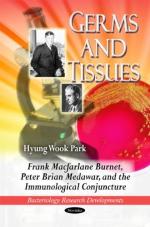|
This section contains 882 words (approx. 3 pages at 300 words per page) |

|
World of Anatomy and Physiology on Frank Macfarlane Burnet
While working at the University of Melbourne's Walter and Eliza Hall Institute for Medical Research in the 1920s, Frank Macfarlane Burnet became interested in the study of viruses and bacteriophage (viruses that attack bacteria). That interest eventually led to two major and related accomplishments. The first of these was the development of a method for cultivating viruses in chicken embryos, an important technological step forward in the science of virology. The second accomplishment was the development of a theory that explains how an organism's body is able to distinguish between its own cells and those of another organism. For this research, Burnet was awarded a share of the 1960 Nobel Prize for physiology or medicine (with Peter Brian Medawar).
Burnet was born in Traralgon, Victoria, Australia. His father was Frank Burnet, manager of the local bank in Traralgon, and his mother was the former Hadassah Pollock MacKay. As a...
|
This section contains 882 words (approx. 3 pages at 300 words per page) |

|


